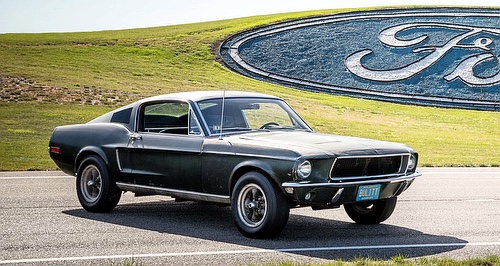News - General NewsUS classic and collectable car values softeningBut Shannons says Australian examples are unaffected… for now12 Aug 2022 MIXED messages are coming out of the US enthusiast car market where inflation – which is currently running at over nine per cent – is starting to slow sales and soften prices of classic and collectible cars.
According to US-based auction houses, buyers have less disposable income and are being charged higher interest rates on debts which, coupled to the effect of a softening stock market, are making investors “think twice” before buying raising a paddle at auction.
Exacerbating the problem is the high price of fuel that is making potential buyers nervous, and the ever-increasing cost of living.
For now, the Australian classic and collectable car markets appear to be buoyant, but similar cost-of-living pressures may see the market here dip over the coming 12-24 months.
The COVID-19 pandemic saw the prices of classic and collectable models spike locally over the past two-end-a-half years as buyers unable to travel invested in desirable models. Prices for Australian muscle and other desirable cars have remained high since the pandemic began, but the US market shows that such heady prices may not be sustained.
Speaking to GoAuto this week, Shannons national auctions manager Christophe Boribon said the local market will need to wait at least six months to see if the price falls witnessed in the United States will impact classic car prices Down Under.
“With inflationary pressures it can cut both ways as people could use a valuable classic car as a hedge against inflation thereby putting upward pressure on prices. On the other hand, they might go the other way,” said Mr Boribon.
“At the moment, it’s a strong market across the board for everything from Aussie classics through to US cars and European cars, everything is strong.”
When asked if he thought Australia might be affected by a downturn in the US he said: “We are a fairly insulated market here so what happens there doesn’t necessarily happen here. We had a 15 per cent spike in prices just after COVID-19 hit and it hasn’t backed off yet.
“I don’t know that interest rate movements have that much influence. If you are asking me to gaze into a crystal ball, I can’t see anything happening, if at all, for at least the next six months.”
At a recent Shannons Classic Car auction, a 1973 Holden Torana XU-1 sold for $146,000 while a 1967 Falcon GT sold for $152,000. If you sold your E37 Valiant Charger 770 at that same auction a few months ago you would have pocketed $200,500.
It would have been $100,000 for the same car in 2017.
Apart from the COVID-19 effect, classic and collectable cars have been a good repository for investment and/or self-managed superannuation funds over the past decade in Australia increasing in value well ahead of the inflation rate for in-demand models of which there are many, especially locally built cars from Holden, Ford and Chrysler.
At the hundreds of Sunday morning car meets that happen around the country, proud owners spruik about their “wheels” giving an insight into how much said classic and collectable cars cost to restore and maintain, and how much they might possibly be worth.
GoAuto attended one such meeting last Sunday in NSW and spoke to an owner about his bronze 1967 XR Falcon GT… the first of the breed.
“I bought this car in a pretty sorry state for $20,000 three years ago and I’ve spent $30,000 on having it repainted in the original bronze, the 289 V8 motor reconditioned and the interior re-upholstered,” he said.
“It owes me about $50,000 which I took out of my super fund, and I did a lot of the work myself. I knocked back an offer of $120,000 last week and I get phone calls all the time from people wanting to buy the car.
“But I’m not selling unless someone is willing to pay me a six-figure price starting with a two.”
Stories abound of buyers paying exorbitant prices for classic Australian cars and some claims might be urban myths. Auctions are the real test of a classic car’s value and checking what various cars achieved at auction is an interesting exercise, giving an insight into their real worth.
As well as Aussie iron, post 1980 Japanese cars are fetching strong prices in Australia, some achieving big money such as a 2000 Mitsubishi Evolution 6.5 Makinen Edition that sold recently at auction for $91,000.
These cars go for even more exported to the US following a relaxation of their import rules for 25-year-old plus cars.
But with concerning information from reliable sources in the US, such as high-profile insurance agent Hagerty's Market Rating, which judges the classic-car market based on several factors, the worries of a flow-on effect here are not without grounds.
Hagerty’s data show the classic car market has dropped for the first time since April 2020. The insurance agent says that inflation is outpacing classic-car appreciation, though values remain very high.
US auto publication Road and Track (R&T) reporting on the enthusiast car market said: “With the stock market falling and interest rates rising to stave off inflation, some enthusiast cars are finally coming back to Earth.”
The report quoted an expert in the field, Doug DeMuro of auction site Cars and Bids who said: “Sellers are showing me comparable sales from 10 to 16 months ago and insisting I set the reserve to match top pricing, but many people, even when confronted with more recent sales evidence, just don’t believe the market has declined from its peak”.
“For the last few years, it seems like the dominant conversation among car enthusiasts is how expensive everything got. Of course, quite literally everything is expensive these days, even mass-market enthusiast cars.
“The pandemic and its resultant effects on the stock market in 2020, a chip shortage that's led to a lack of new car inventory and growing interest in enthusiast cars, combined with various other factors that led to skyrocketing prices across a spectrum of vehicles.
“There are signs that the market is cooling down, however. At least, it is in certain segments.”
Mr DeMuro told R&T he believed over-valuing of classic cars had helped in part to cause the bubble to burst, admitting some auction prices had got a “little out of control”.
“I think in an inflationary period, and especially if we believe it was an inflationary bubble period as I do, then by definition there was overvaluing.
“Things kind of got a little out of control and obviously the federal reserve, and the government in general, are trying to change their monetary supply tactics to try to make things less inflationary.
“But, you know, I really believe that stuff's worth what people pay for it at the end of the day. People thought they (cars) were worth ‘X’ at the time, but that was in a situation where everything was getting crazy expensive and interest rates were really low, so debt was cheap.
“Top shelf enthusiast cars aside, for those looking at more attainable, yet still aspirational enthusiast cars, the realities are different. What we're seeing right now is that the markets have tightened, especially the stock markets, people don't quite have as much money as they thought they did six months ago. “Without the benefit of much hindsight, it's hard to say exactly when the softening started, though I think it was likely earlier this year with markets falling and interest rates rising.”  Read more |
Click to shareGeneral News articlesResearch General News Motor industry news |















Facebook Twitter Instagram